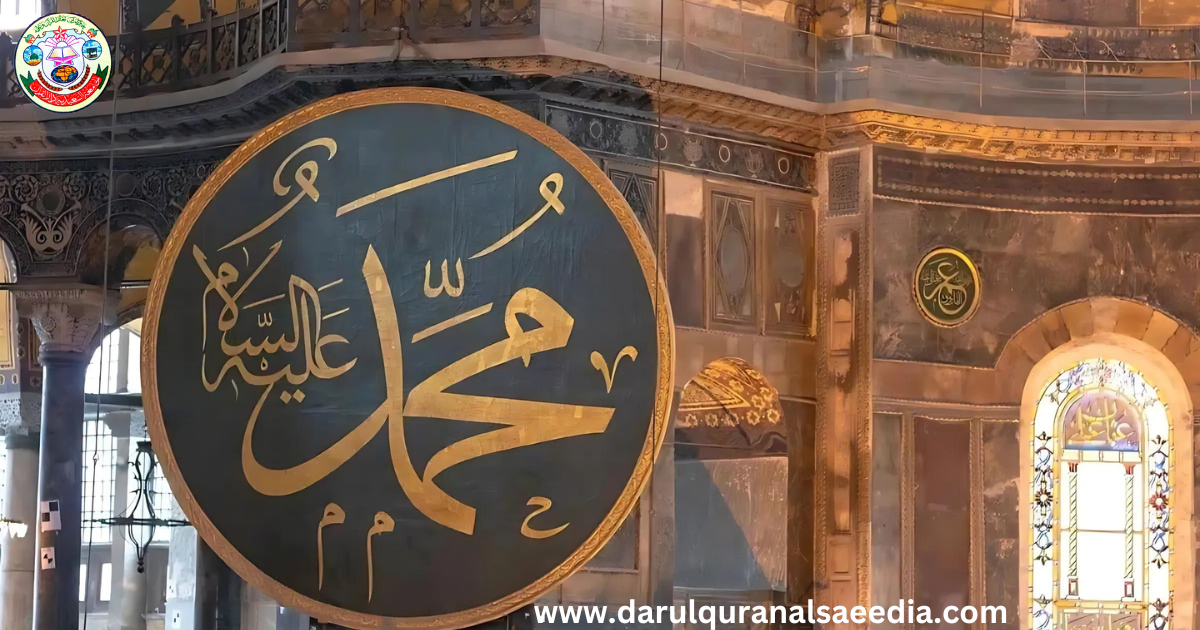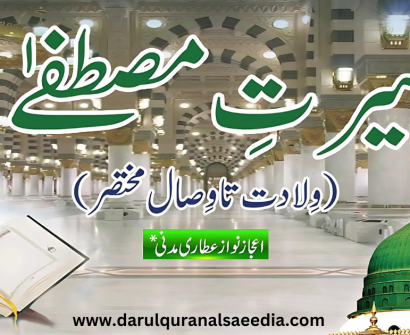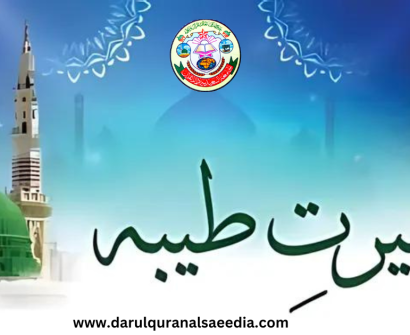Holy Prophet Hazrat Muhammad (ﷺ) Celebrating the Life and Legacy

Birth
Holy Prophet Hazrat Muhammad ﷺ was born around 570 AD in the city of Mecca, located in the Arabian Peninsula. His full name was Muhammad ibn Abdullah ibn Abdul-Muttalib. He was born into the powerful Quraysh tribe, which controlled Mecca and its important Kaaba shrine.
Muhammad ﷺ’s father, Abdullah, died before he was born, and his mother, Aminah, passed away when he was only six years old. He was then raised by his grandfather, Abdul-Muttalib, and after his grandfather’s death, by his uncle, Abu Talib.
Read More: 41st International Almi Milad Conference 2024
Holy Prophet Hazrat Muhammad (ﷺ) Early Life and Upbringing
As a child, Muhammad ﷺ was known for his honesty, trustworthiness, and kind nature, earning him the nickname “Al-Amin” (the Trustworthy). He spent his early years as a shepherd, which was a common occupation for young boys at the time.
At the age of nine, Muhammad ﷺ accompanied his uncle Abu Talib on a trade journey to Syria, where he was recognized by a Christian monk named Bahira, who predicted that Muhammad would become a great prophet.
Marriage to Khadijah
When Muhammad ﷺ was around 25 years old, he began working as a merchant for a wealthy widow named Khadijah bint Khuwaylid. Impressed by his honesty and integrity, Khadijah proposed marriage to him, and he accepted. This was Muhammad’s ﷺ only marriage until Khadijah’s death, about 25 years later. Together, they had several children, including their daughter Fatimah, who would later marry Muhammad’s cousin, Ali ibn Abi Talib.
The Revelations and the Beginning Muhammad ﷺ of Islam
In the year 610 AD, when Muhammad ﷺ was around 40 years old, he began receiving revelations from God through the angel Gabriel. These revelations, which continued over the next 23 years, would form the basis of the Quran, the holy book of Islam.
The first revelation occurred while Muhammad ﷺ was meditating in a cave called Hira on Mount Jabal al-Nour near Mecca. There, the angel Gabriel appeared to him and commanded him to “Recite!” Muhammad ﷺ was initially overwhelmed and frightened by the experience, but Khadijah reassured him and became one of the first believers in his prophetic Muhammad ﷺ mission.
Early Preaching and Persecution in Mecca
After receiving the first revelations, Muhammad ﷺ began preaching the message of Islam, which called for the worship of one God (Allah) and the rejection of the polytheistic beliefs and idolatry that were prevalent in Mecca at the time.
This new monotheistic message angered many of the Meccan leaders, who were concerned about the potential impact on their lucrative trade and the worship of their pagan deities. As a result, Muhammad ﷺ and his followers faced Muhammad ﷺ increasing persecution and opposition from the Meccan establishment.
The Hijra (Migration) to Medina
In 622 AD, after years of harassment and threats, Muhammad ﷺ and his followers were forced to flee Mecca for the city of Medina, about 260 miles to the north. This event, known as the Hijra, marks the beginning of the Islamic calendar and the establishment of the first Muslim community under Muhammad’s leadership.
In Medina, Muhammad ﷺ continued to receive revelations and consolidate his teachings, while also working to resolve conflicts between the various tribes and factions living in the city. He established the first mosque and laid the foundations for a new social and political order based on the principles of Islam.
Battles and Conquest of Mecca
Over the next few years, Muhammad ﷺ and his followers were involved in a series of battles with the Meccans, who were determined to eliminate the growing threat posed by the new Muslim community. Notable battles included the Battle of Badr, the Battle of Uhud, and the Battle of the Trench.
Despite these conflicts, Muhammad ﷺ eventually led his followers back to Mecca in 630 AD, where they conquered the city with minimal bloodshed. Muhammad ﷺ then proceeded to cleanse the Kaaba of its idols, solidifying the triumph of monotheism and establishing Mecca as the spiritual center of the new Islamic faith.
The Farewell Pilgrimage and Death
In 632 AD, Muhammad ﷺ just a few months before his death, Muhammad ﷺ performed his only pilgrimage to Mecca, known as the Farewell Pilgrimage. During this journey, he delivered a famous sermon, outlining the principles of Islamic faith and the rights and obligations of Muslims.
Shortly after his return to Medina, Muhammad ﷺ fell ill and died on June 8, 632 AD, at the age of 62. He was buried in Medina, and the city became the first capital of the Rashidun Caliphate, the first of the major Islamic caliphates that would follow.
Legacy and Impact
Prophet Muhammad ﷺ is revered by Muslims as the final prophet in a long line of messengers sent by God, including figures like Abraham, Moses, and Jesus. His teachings and the revelations he received, compiled in the Quran, form the foundation of the Islamic faith, which now has over 1.8 billion followers worldwide.
Muhammad’s ﷺ life and legacy have had a profound impact on world history, shaping the religious, social, and political landscape of the Middle East and beyond. He is remembered not only as a prophet but also as a military leader, statesman, and social reformer who worked to promote justice, equality, and the empowerment of the marginalized.
Today, Muslims around the world continue to honor and emulate the teachings and example of Prophet Muhammad ﷺ, known as the “Seal of the Prophets” Muhammad ﷺ and the “Mercy to all Worlds.”
The Night Journey and Ascension (Mi’raj)
One of the most significant events in the life of Prophet Muhammad (ﷺ) is the Night Journey and Ascension (Mi’raj). According to Islamic tradition, one night while the Prophet was sleeping, the angel Gabriel came to him and took him on a miraculous journey.
First, they traveled from Mecca to Jerusalem, where Muhammad (ﷺ) led a prayer with other prophets. Then, he was taken up through the heavens, where he was granted a vision of the afterlife and had a direct encounter with God. This event is seen as a testament to Muhammad’s (ﷺ) prophethood and his close connection Muhammad ﷺ with the divine.
Wives and Family Life
In addition to his marriage to Khadijah, Prophet Muhammad (ﷺ) had several other wives over the course of his life. These included Aisha, the daughter of his close companion Abu Bakr, as well as Hafsa, Umm Salamah, Zaynab bint Jahsh, and others.
Muhammad’s (ﷺ) marriages were not solely for personal reasons but also served political and social purposes, helping to forge alliances and support the growing Muslim community. Many of his wives were also influential figures in their own right, contributing to the spread and interpretation of Islamic teachings.
The Prophet’s (Muhammad ﷺ) children included sons who died in infancy, as well as his daughter Fatimah, who married his cousin Ali ibn Abi Talib. Fatimah and Ali’s descendants, known as the Ahl al-Bayt or the People of the Household, hold a special place in Shia Islam.
Hadith and the Sunnah
In addition to the Quran, which contains the revelations received by Muhammad (ﷺ), Muslims also rely on the Hadith, which are the recorded sayings, teachings, and actions of the Prophet. Together, the Quran and Hadith form the basis of the Sunnah, or the normative example of how Muslims should live their lives.
The Hadith were meticulously collected and documented by Muhammad’s (ﷺ) companions and later generations of scholars, who established rigorous criteria for verifying the authenticity of each report. This corpus of literature provides invaluable insight into the Prophet’s (ﷺ) life, teachings, and the early development of Islamic civilization.
The Seerah and Biographies of Prophet Muhammad (ﷺ)
The life and times of Prophet Muhammad (ﷺ) have been the subject of extensive biographical and historical accounts, known as the Seerah. These works, compiled by early Muslim scholars, offer a wealth of information about the Prophet’s (ﷺ) birth, upbringing, prophetic mission, and the key events that shaped the early Islamic community.
Some of the most influential Seerah works include:
- Al-Raheeq al-Maktum by Saifur Rahman al-Mubarakpuri
- Khatam al-Nabiyeen by Dr. Majid Ali Khan
- Paygambar e Azam wa Akher by Dr. Nasir Ahmed Nasser
- Muntaka’ al-Nakool fi Seerat Azam Rasool by Sheikh Hamid Mahmud ibn Mohammad Mansur
- Seerat al-Nabiy al-Hadiy ar-Rahmah by Muhammad ﷺ Ustadh Abd al-Salam Hasim Hafiz
These and other Seerah texts provide a comprehensive and authoritative account of Prophet Muhammad’s (ﷺ) life, offering valuable insights into the historical, social, and spiritual context of the emergence of Islam.
The Spread of Islam and the Caliphates
After the death of Prophet Muhammad (ﷺ) in 632 AD, the Muslim community faced the challenge of finding a suitable successor, or Caliph, to lead the rapidly expanding Islamic civilization. This led to a split between the Sunni and Shia branches of Islam, each with its own interpretation of legitimate leadership.
The first four Caliphs, known as the Rashidun Caliphs, were Abu Bakr, Umar, Uthman, and Ali. They oversaw the initial expansion of Islamic rule, with the Rashidun Caliphate stretching from the Iberian Peninsula to the Indus Valley.
This was followed by the Umayyad Caliphate, based in Damascus Muhammad ﷺ, and the Abbasid Caliphate, based in Baghdad, which continued to propagate Islamic teachings and culture across a vast geographical area. The Caliphates played a crucial role in the Golden Age of Islamic civilization, which saw remarkable achievements in fields such as mathematics, science, philosophy, and the arts.
The Influence of Prophet Muhammad (ﷺ) on World History
The legacy of Prophet Muhammad (ﷺ) extends far beyond the religious sphere, as his life and teachings have had a profound impact on world history and civilization. As the founder of Islam, he has shaped the beliefs, practices, and cultural traditions of over 1.8 billion Muslims worldwide.
But Muhammad’s (ﷺ) influence has also extended to areas such as law, social justice, and the empowerment of marginalized communities. He advocated for the rights of women, slaves, and the poor, and his teachings have been instrumental in the development of Islamic Muhammad ﷺ jurisprudence and the concept of an equitable society.
Moreover, the Prophet’s (ﷺ) emphasis on education, knowledge, and intellectual pursuits has had a lasting impact on the advancement of science, philosophy, and the arts, particularly during the Golden Age of Islamic civilization.
Today, Prophet Muhammad (ﷺ) remains a revered and inspirational figure, not only for Muslims but also for scholars, historians, and anyone interested in understanding the rich tapestry of human civilization and the profound influence of religious and spiritual leaders.
The Concept of Jihad in Islam
One of the most misunderstood and controversial aspects of Prophet Muhammad’s (ﷺ) teachings is the concept of Jihad. In Islam, Jihad is often interpreted as the “struggle” or “striving” to uphold and defend the faith, both in a spiritual and a physical sense.
While the term has sometimes been associated with violent extremism, the Prophet’s (ﷺ) own understanding and practice of Jihad emphasized the importance of inner spiritual purification, as well as the just defense of the Muslim community against aggression and oppression. The Prophet (ﷺ) himself engaged in military campaigns, but these were primarily defensive in nature, aimed at protecting the fledgling Islamic state and its followers.
In the modern era, Muslim scholars and thinkers have engaged in extensive debates and reinterpretations of the concept of Jihad, emphasizing its spiritual and Muhammad ﷺ non-violent dimensions while condemning the use of unjustified violence in the name of religion.
Perspectives on Prophet Muhammad (ﷺ) in the Western World
The figure of Prophet Muhammad (ﷺ) has been the subject of intense scrutiny and often-conflicting perceptions in the Western world. Throughout history, the Prophet’s (ﷺ) life and teachings have been viewed through a variety of lenses, ranging from outright hostility and demonization to more nuanced and empathetic understanding.
In the medieval period, Christian polemicists often portrayed Muhammad (ﷺ) as a false prophet and an impostor, while later Enlightenment scholars began to adopt a more impartial, if still critical, approach to his life and legacy. In the modern era, the Western perception of the Prophet (ﷺ) has been shaped by a range of factors, including geopolitical tensions, cultural differences, and the ongoing struggle to combat Islamophobia and promote interfaith understanding.
Despite these challenges, a growing number of Western scholars and intellectuals have recognized the profound influence of Prophet Muhammad (ﷺ) on world history and the enduring relevance of his teachings for contemporary society. These perspectives have contributed to a more balanced and nuanced understanding of the Prophet’s (ﷺ) life and the rich tapestry of Islamic civilization.
Artistic and Literary Representations of Prophet Muhammad (ﷺ)
The life and legacy of Prophet Muhammad (ﷺ) have been a source of inspiration for countless artists, writers, and intellectuals throughout history. While the depiction of the Prophet’s (ﷺ) physical likeness is generally avoided in Islamic tradition, his story and teachings have been reimagined and reinterpreted in various forms of artistic and literary expression.
In the Islamic world, the Prophet’s (ﷺ) biography, known as the Seerah, has been the subject of numerous poetic and narrative works, often featuring detailed descriptions of key events and spiritual insights. Similarly, the Hadith, or the recorded sayings and actions of the Prophet (ﷺ), have been the inspiration for countless works of Islamic art, calligraphy, and architecture.
In the Western world, the figure of Prophet Muhammad (ﷺ) has also been the subject of significant literary and artistic engagement, ranging from historical biographies to creative fictional works. These representations have often reflected the shifting attitudes and perceptions of the Prophet (ﷺ) in the Western imagination, from early demonization to more nuanced and empathetic portrayals.
Ultimately, the enduring fascination with Prophet Muhammad (ﷺ) in the realms of art and literature is a testament to his profound impact on the human experience and the ongoing quest to understand the complex interplay between faith, culture, and the human condition.
The Significance of Prophet Muhammad (ﷺ) in the Modern Age
In the modern age, the life and teachings of Prophet Muhammad (ﷺ) continue to hold immense significance, both for the global Muslim community and for the world at large. As the founder of Islam, the Prophet’s (ﷺ) legacy has shaped the religious, social, and political landscape of the Middle East and beyond, with his influence extending to areas as diverse as law, ethics, and the arts.
In the face of contemporary challenges, such as religious extremism, social injustice, and the ongoing struggle for interfaith understanding, the Prophet’s (ﷺ) emphasis on compassion, justice, and the unity of humanity remains profoundly relevant. His teachings on the rights of women, the protection of the vulnerable, and the pursuit of knowledge have continued to inspire Muslims and non-Muslims alike in their efforts to build a more equitable and just world.
Moreover, as the global community grapples with issues such as environmental degradation, economic inequality, and the need for sustainable development, the Prophet’s (ﷺ) vision of a harmonious relationship between humanity and the natural world, as well as his emphasis on moderation and the equitable distribution of resources, offer valuable insights and guiding principles.
Today, the legacy of Prophet Muhammad (ﷺ) continues to be celebrated and studied by scholars, spiritual leaders, and people from all walks of life, who recognize the enduring relevance of his teachings and the profound impact he has had on the course of human history.
Read More: Holy Prophet Hazrat Muhammad
FAQs
Q: When was Prophet Muhammad (ﷺ) born?
A: Prophet Muhammad (ﷺ) was born around 570 AD in the city of Mecca, located in the Arabian Peninsula.
Q: Who were Prophet Muhammad (ﷺ)’s parents?
A: Prophet Muhammad (ﷺ)’s father, Abdullah, died before he was born, and his mother, Aminah, passed away when he was only six years old.
Q: What was Prophet Muhammad (ﷺ)’s childhood like?
A: As a child, Prophet Muhammad (ﷺ) was known for his honesty, trustworthiness, and kind nature. He spent his early years as a shepherd.
Q: Who was Khadijah bint Khuwaylid?
A: Khadijah bint Khuwaylid was a wealthy widow who proposed marriage to Prophet Muhammad (ﷺ) and became his first wife.
Q: When did Prophet Muhammad (ﷺ) receive his first revelation?
A: The first revelation of the Quran was received by Prophet Muhammad (ﷺ) in the cave of Hira on Mount Jabal al-Nour in the year 610 AD.
Q: What was the Hijra?
A: The Hijra was the migration of Prophet Muhammad (ﷺ) and his followers from Mecca to Medina in 622 AD, which marks the beginning of the Islamic calendar.
Q: Who were the Rashidun Caliphs?
A: The Rashidun Caliphs were the first four successors to Prophet Muhammad (ﷺ), who led the early Islamic community.
Q: What is the Sunnah?
A: The Sunnah is the recorded sayings, teachings, and actions of Prophet Muhammad (ﷺ), which serve as a guide for Muslims.
Q: What is the significance of the Night Journey and Ascension (Mi’raj)?
A: The Night Journey and Ascension (Mi’raj) was a miraculous journey taken by Prophet Muhammad (ﷺ), during which he visited Jerusalem and ascended to the heavens.
Q: Who were Prophet Muhammad (ﷺ)’s wives?
A: Prophet Muhammad (ﷺ) had several wives, including Khadijah bint Khuwaylid, Aisha, Hafsa, Umm Salamah, and Zaynab bint Jahsh.
Q: How did Prophet Muhammad (ﷺ) influence world history?
A: Prophet Muhammad (ﷺ) founded Islam, which has over 1.8 billion followers worldwide. His teachings have shaped the religious, social, and political landscape of the Middle East and beyond.
Q: What is the concept of Jihad in Islam?
A: Jihad is the “struggle” or “striving” to uphold and defend the faith, both in a spiritual and a physical sense.
Q: How is Prophet Muhammad (ﷺ) perceived in the Western world?
A: The perception of Prophet Muhammad (ﷺ) in the Western world has been complex and varied, ranging from hostility to more nuanced and empathetic understanding.
Q: What is the significance of Prophet Muhammad (ﷺ) in the modern age?
A: Prophet Muhammad (ﷺ)’s teachings on compassion, justice, and the unity of humanity remain relevant in today’s world, inspiring Muslims and non-Muslims alike.
Q: What are some famous Seerah works about Prophet Muhammad (ﷺ)?
A: Some famous Seerah works include “Al-Raheeq al-Maktum” by Saifur Rahman al-Mubarakpuri, “Khatam al-Nabiyeen” by Dr. Majid Ali Khan, and “Seerat al-Nabiy al-Hadiy ar-Rahmah” by Ustadh Abd al-Salam Hasim Hafiz.
Q: How can I learn more about Prophet Muhammad (ﷺ)?
A: You can learn more about Prophet Muhammad (ﷺ) by reading biographies, studying the Quran and Hadith, attending lectures, and participating in Islamic events.
Q: What is the best way to honor Prophet Muhammad (ﷺ)?
A: The best way to honor Prophet Muhammad (ﷺ) is to follow his teachings, strive to live a righteous life, and spread his message of peace and compassion.












